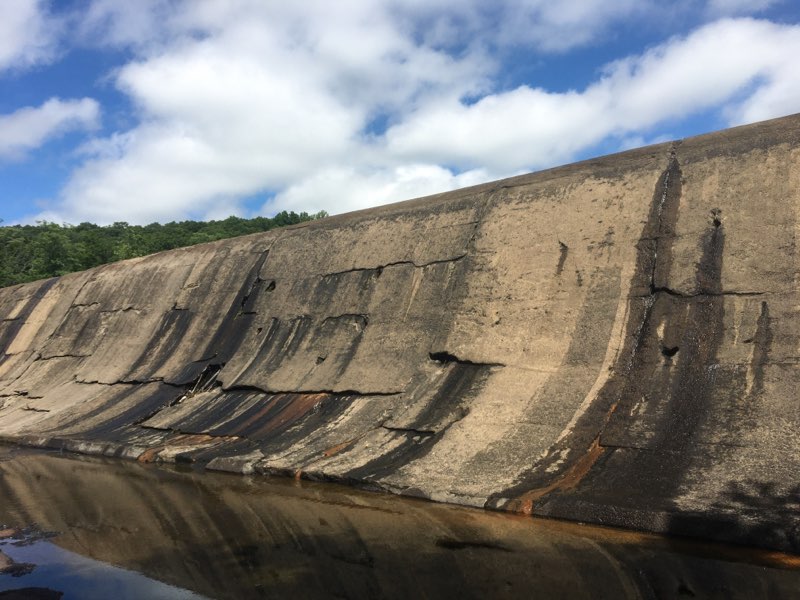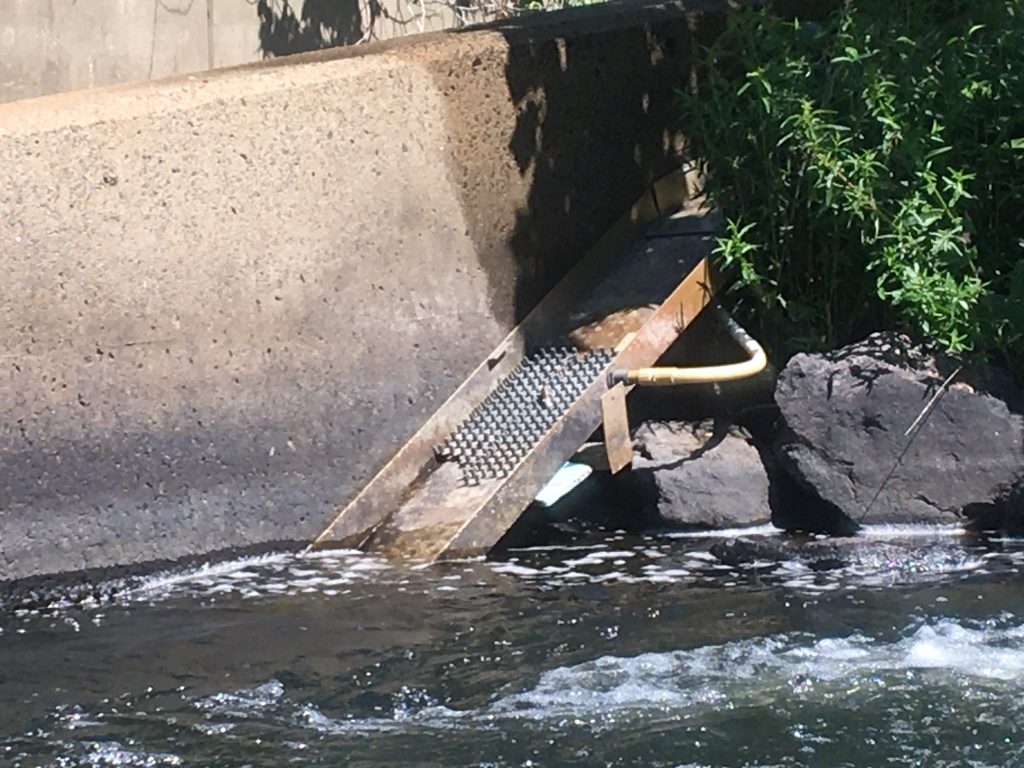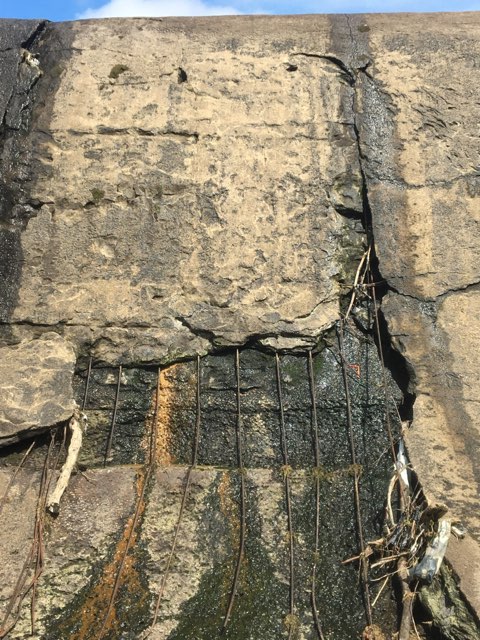Kinneytown Dam, owned by Hydroland Corporation, is the last remaining barrier to migratory fish on the Naugatuck River, blocking access to over 32 river miles of spawning habitat. Currently, fish are unable to pass the dam due to improper hydropower operations and an ineffective fish ladder. But support for restoring fish passage at Kinneytown is significant and growing. Pressure to do so has come to a head through a Federal Energy Regulatory Commission (FERC) investigation into the dam’s license compliance initiated by the U.S. Fish and Wildlife Service, which has drawn interest and comment from Save the Sound, Naugatuck River Revival Group (NRRG), 19 municipalities represented by the Naugatuck Valley Council of Governments, and countless other community partners.

The pre-industrial Naugatuck River supported runs of Atlantic salmon, shad, alewife, blueback herring, American eel, sea lamprey and many other species of fish and wildlife.
Like many Connecticut rivers, the Naugatuck River historically supported runs of diadromous fish (species that spend part of their lifecycle in freshwater and part in saltwater). Unfortunately dam construction from the mid-1700s to the mid-1900s disrupted or eliminated these runs, even as riverside development, sewage, and manufacturing discharges further reduced water quality. By the 1950s, surveys revealed very little life left in the river. The Naugatuck River was so polluted that in 1943, the river actually caught fire.
Great strides have been made in restoring the Naugatuck River over the last several decades. Residents used to know what was being manufactured upstream on any given day based on the color of the river; thanks to the Clean Water Act, it is now home to trophy trout fishing, numerous osprey nests, and a bald eagle nest. While there is still a long way to go and much work to do, water quality improvements have been a significant success story. Progress on removing barriers and reopening the river came in a burst of activity around the turn of the millennium, but now faces its most significant challenge yet.
With extensive upriver dam removals and fish passage completed, including a $6.3M investment in a bypass in Seymour, the Kinneytown Dam is the sole remaining barrier to restoring fish runs all the way from Long Island Sound to Thomaston.
As many factories closed, most dams on the Naugatuck River ceased to provide hydropower or serve any other economic purpose. Beginning at the dawn of America’s dam removal movement, Anaconda, Freight Street, Union City, Platts Mill, and Chase Brass Dams were removed between 1999 and 2004, and in 2014 a fish bypass channel was built at the Tingue Dam in Seymour just upstream of the Kinneytown Dam. While the Tingue bypass has run into problems, through adaptive management the state is currently in process to resolve the issue and bring this essential fish passage back on line.
The removal of five dams on the Naugatuck has restored not only resident fish passage, but has restored natural riverine processes. Rivers are the arteries of the landscape, delivering oxygen and sediment to its toes in the estuary and nutrients all the way to its fingertips to Thomaston. Where the Anaconda Dam once stood, there are now gravel spawning beds, more familiar to fishermen on the wild and scenic Farmington River than on the industrial Naugatuck. The Naugatuck River’s story is one of recovery and resilience.
Dam removal is the best alternative to restore our rivers to a natural free-flowing state. Fish passage alternatives, including fishways, are installed when dam removal is infeasible and can be successful and important to reconnect migratory fish runs for a select number of species. To mitigate some of the effects of run-of-river dams on fish and wildlife, FERC requires hydropower operators to provide safe, timely and effective passage.
Kinneytown Dam does feature a fish ladder constructed in 1999, which, if effective, would allow passage for select species of fish. However, due to a lack of maintenance and poor operation of the dam and its power works, very few fish—and for some species, none—are able to pass the dam en route to their historic spawning grounds upstream. The barrier to migratory fish at the Kinneytown Dam effectively renders the Tingue Dam bypass a $6.3 million stranded asset, and dilutes the impact of all of the other upstream dam removals by preventing the establishment of healthy anadromous runs that benefit many other species of wildlife and human economies.

If the Kinneytown Dam were no longer an impediment to migratory fish they would have access to 32 miles of the Naugatuck River—as well as 8 miles of its tributaries—which include significant spawning and rearing habitat. DEEP has estimated that the Naugatuck could support a run of 20,000 shad and a 30,000 river herring from Kinneytown to Thomaston.
The Kinneytown Dam is currently violating its FERC license exemption by not providing adequate fish passage.
When Kinneytown Dam became a hydropower dam in 1983, it was granted a Federal Energy Regulatory Commission (FERC) exemption, essentially a perpetual license exempted from renewal. As a condition of that exemption, the dam operators are required to 1) operate both of their power stations, 2) provide safe, timely, and effective fish passage upstream and downstream, 3) provide minimum stream flow, and 4) maintain dam safety. We believe they are out of compliance with many or all of these requirements.

There are two reasons that we believe the current fish passage at Kinneytown is ineffective. First, by failing to operate both of the power stations, flow over the dam causes “false attraction” that attracts fish to the face of the dam instead of the entrance to the fish ladder. Fish are left stranded, often dying from predation (see a video of this). Second, while the fish ladder itself has not been tested for effectiveness, it is clear from the fish passage numbers in the years prior to the second plant’s shutdown that only small numbers of fish — less than a hundred shad in a decade — were passing. Today, with only one plant operating, video observations from the NRRG show the situation to be even worse, with numerous individuals of various species of fish failing to locate the entrance to the fish ladder. Therefore, we believe that even when the dam is operating as intended the fish ladder does not provide safe, timely, and effective fish passage, and that it is essentially a barrier in its current state. Enforcing the conditions of the FERC license exemption can result in either the provision of proper fish passage by the dam’s operators, or the revocation of the exemption.
Save the Sound’s Legal Team, Ecological Restoration Team, and Soundkeeper Bill Lucey are working together with nonprofit and municipal partners to ensure that FERC, the U.S. Fish and Wildlife Service, and CT DEEP strictly enforce the conditions of Kinneytown’s exemption and restore fish passage on the Naugatuck River.
The U.S. Fish & Wildlife Service has initiated a process with FERC to direct the operator of the Kinneytown Dam, Hydroland, to develop a plan to operate the hydroelectric facility as required by the license exemption. Save the Sound and its partners are in communication with U.S. Fish & Wildlife Service and CT DEEP staff to support the agencies’ enforcement efforts by sharing on-the-ground observations and analysis of the significance of the failure of Kinneytown’s fish passage to the Naugatuck River and Long Island Sound ecosystems. On November 30th, Save the Sound and Naugatuck River Revival Group submitted joint comments to FERC on this matter. The Legal Team will engage fully in the FERC investigation and subsequent enforcement proceedings.
For years, the Naugatuck River Revival Group and other concerned neighbors and environmentalists have been sounding the alarm about Kinneytown Dam and documenting the plight of fish stranded below it. Now momentum is growing for a permanent, effective solution that will reopen this mighty river and restore access for tens of thousands of migratory fish, making the Naugatuck part of the story of growing abundance across the Long Island Sound region.
Learn more and stay updated on the effort to restore fish passage at Kinneytown Dam by visiting the dedicated page for this project and learning about the history of our efforts through NVCOG’s interactive storymap.
